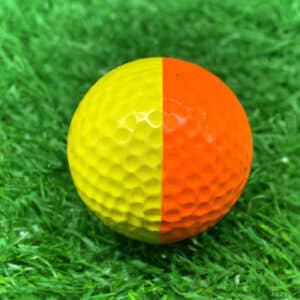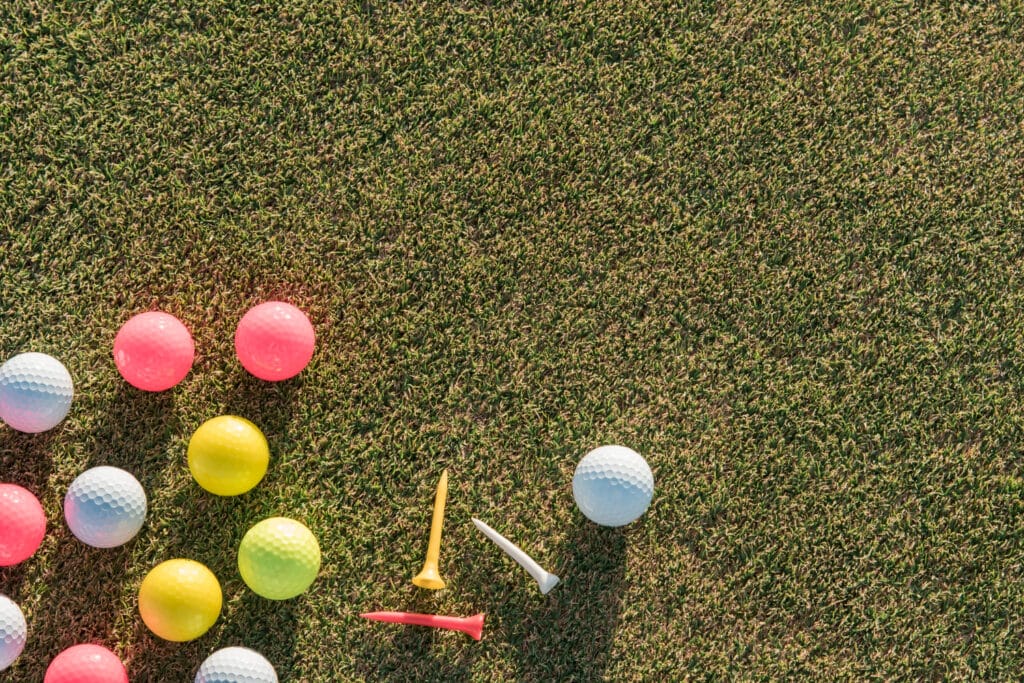Last Updated on June 6, 2023
Have you ever been out on the golf course and had trouble seeing your ball? It’s a common problem for all golfers, but it doesn’t have to be. Knowing which colour golf ball is easiest to see can help improve your game significantly. In this article, we’ll explain why some colours stand out better than others and make recommendations accordingly.
Types of Golf Ball Colours
Golf balls come in a variety of different colours, each with its own purpose. The most common golf ball colour is white as it allows players to identify the spin on their shots more easily and also stands out against other coloured golf balls. However, there are many brightly-coloured options out there such as orange, pink, yellow, green and purple. These alternative colours can help distinguish between balls when playing in groups or make them easier to spot if they land off the fairway.
Visual Perception of Colours
When it comes to golf ball colours, visual perception plays a major role in determining which colour is easiest to see. Although the hue of the golf ball may seem like an important factor, brightness perception and overall colour perception are also crucial in choosing the right one. For example, if someone has difficulty distinguishing between certain shades or hues, they might prefer a brighter-coloured golf ball that stands out more when searching for it on the course. On the other hand, individuals with some form of colour blindness might find an orange or pink coloured golf ball easier to differentiate from their surroundings than a white one.
By taking into account all aspects related to visual perception and personal preference, everyone can find a suitable golf ball that suits their needs and helps enhance their performance on the course.
Effects of Light on Colour Visibility
The effects of light on colour visibility are complex and varied. Light reflection, light intensity, and light conditions all play a role in determining how well different colours can be seen by the human eye.

Generally speaking, golf balls that have bright/light colours with good reflectivity stand out best in most conditions. This includes white, yellow, pink, orange, etc., as they will show up more clearly than darker-coloured ones, like black or blue. Additionally, when there is an uneven distribution of lighting across the course (such as direct sunlight), certain optical illusions may occur which could cause one to misjudge the colour of their ball. Therefore it’s important for players to pay attention to these factors when selecting a golf ball:
- Reflection: How much does this particular colour reflect off of other surfaces? White and yellow tend to have higher levels of reflection compared to other colours. Darker shades such as black tend to absorb more light rather than reflect it
- Intensity: Does the surrounding environment make it difficult for one to distinguish between different tones? Bright environments can lead to decreased contrast between same-coloured objects. Dimly lit situations can reduce visual acuity and make it hard for players to determine where their ball lies
- Conditions: Is there any external factor impairing your vision such as fog or rain? Foggy environments can create false shadows making it harder for players to identify their ball quickly. Rainy days decrease visibility due to increased glare from wet surfaces
Overall, while darkly coloured golf balls may look nice aesthetically at first glance, lighter-coloured options ultimately provide better results since they stand out easier under varying environmental conditions.
Factors That Affect the Visibility of a Golf Ball
When considering which colour golf ball is easiest to see, there are a variety of factors that can affect visibility. Ball size, light conditions, and the surrounding environment all play important roles in influencing how easily a golf ball can be seen. Additionally, reflective properties and colour contrast also influence visibility.
Ball size has an impact on visibility because larger balls tend to stand out more from their surroundings than smaller balls do. Light conditions, such as whether it’s day or night, can change what colours will appear most bright against the background. The amount of natural light available may also vary depending on certain weather patterns like fog or overcast skies. Furthermore, the surrounding environment – for example, grassy fields versus sandy areas – affects visibility by determining the level of contrast between the ball and its background.
The reflective properties of a golf ball’s surface such as texture and glossiness also make a difference in seeing them clearly. Finally, colour contrast plays an essential role when determining how easy it is to spot a golf ball; lighter-coloured balls typically stand out better against darker backgrounds while dark-coloured golf balls may be easier to see under brighter lighting conditions. All these elements should be taken into account when trying to determine which colour golf ball is easiest to see in any given situation.
Strategies to Improve Visibility
The most important aspect of golf ball spotting is being able to see the ball’s location. Generally, bright colours are easier for the eyes to pick up and track from a distance. A 3×3 table below illustrates some strategies to improve visibility:
| Bright Colours | Visual Tracking | Seeing Distance |
|---|---|---|
| Choose yellow or orange coloured balls | Keep your head still while looking at the ball in motion | Use binoculars when necessary |
| Mix two-tone patterns on the ball surface | Trace lines with eye towards the targeted area where you expect the ball to land | Focus on target rather than watching entire flight path of the ball |
By using these techniques, it can help increase overall accuracy and enjoyment during play. It may also reduce time spent searching for lost balls as well as develop better habits that will positively impact long-term performance. Having good vision aids such as lenses or sunglasses can provide clear visuals when tracking the direction of a golf shot so one can make more precise decisions quicker and easier. Ultimately, being aware of these tips should result in improved game performance and reduced frustration.
Role of Contrast in Detecting the Ball
Having good visibility of the golf ball is essential to perform well on the course. The colour of the golf ball plays an important role in its detection and hence, it is necessary to choose one that provides maximum contrast with its surroundings. Contrasting colours ensure better visibility under different light conditions which may vary from one part of the golf course to another.
Brightly coloured balls such as orange or yellow are usually easier to spot than white or black ones under most lighting conditions, especially during low-light situations like dusk or dawn. White balls tend to get lost among background objects whereas dark-coloured balls can be more difficult for players to detect when there’s not enough light available. For example, when playing at nighttime, fluorescent green or pink balls can make it much easier for players to find their ball without having to search around too much.
Overall, choosing a brightly coloured golf ball is recommended if you want greater visual clarity while out on the course and help improve your performance. With this knowledge in mind, selecting the right colour should be no problem so you can stay focused on achieving lower scores!
Colour Combinations for Improved Detection

Brightly coloured golf balls are the easiest to see and therefore the most popular choice for golfers. Many players opt for a combination of two colours, such as yellow and orange or green and blue. These combinations create a “high-visibility” look that makes it easier to track and follow the ball in flight. Multi-coloured options like camouflage and rainbow patterns offer improved visibility without sacrificing performance.
Golfers can also incorporate ball visibility strategies into their games by using a variety of colour combinations on different shots. For example, they might use one bright colour for fairway shots and another colour for approaches into greens or sand traps. This way, they don’t have to worry about losing sight of where their ball is located at any time during their round. Additionally, this strategy can help them identify which club they used on each shot with ease.
By utilising these various golf ball colour combinations, players can enhance their visibility while playing more confidently and effectively. With some advanced planning before teeing off, golfers will be able to hit purer shots due to improved tracking capabilities on every swing.
Advantages and Disadvantages of Different Coloured Balls
Now that we know the basic principles of colour combinations and how they can help improve detection, let’s take a look at the advantages and disadvantages of different coloured golf balls. There are many factors to consider when choosing between colours, from long-distance visibility to better contrast for improved accuracy.
Advantages:
- Long-distance visibility: Brighter colours like yellow, orange or pink stand out more in low-light settings, making them easier to spot from far away when searching for your ball.
- Improved Accuracy: Darker colours such as blue or black provide higher contrast against green grass which makes it easier line-up shots accurately.
Disadvantages:
- Low Light Visibility: While brighter colours may be easy to see during the day, they become almost invisible in dim lighting so darker colours should be used instead.
- Reduced Distance Control: Because lighter colours show less spin on the ball than dark ones do, you will have reduced control over its trajectory due to lowered backspin levels.
Choosing an appropriate coloured golf ball not only affects your overall game performance but also enhances safety by making it easier for other players to locate your shot. It is important to weigh all these factors before deciding what works best for you.
Benefits Of Brightly Colored Balls For Beginners And Children

Brightly coloured golf balls offer many benefits for beginners and children. For one, they can easily be seen by the golfer while they are playing. This is especially important when looking for a lost ball in tall grass or rough areas on the course. The bright colours of these beginner golf balls help to make them stand out from their surroundings, increasing visibility significantly. In addition to this, brightly coloured golf balls are often easier for players with color blindness or other vision impairments to see than traditional white golf balls.
The increased visibility that comes with brightly coloured beginner and children’s golf balls helps new players learn the game faster and gives them an advantage over more experienced players who may not have access to such technology. Brightly coloured golf balls also allow kids to practice without worrying about losing their ball since it will always be easy to spot on the fairways and greens. All in all, using brightly coloured beginner and children’s golf balls provides a multitude of advantages which makes learning the fundamentals of golf much easier.
Frequently Asked Questions
What Is The Most Popular Colour Golf Ball?
When it comes to golf ball colours, the most popular colour golf ball is usually either white or yellow. Popular golf ball colours are determined by the colouring of a golf ball and the various colour choices available. There are several options when it comes to choosing a colour for your golf balls:
- White
- Yellow
- Orange
- Pink
These four colours are typically considered to be the main golf ball colour options and they offer visibility on any course – which makes them ideal for players of all skill levels. Moreover, there is no definitive answer as to what exact shade of each colour you should use; rather, this will depend on personal preference and playing conditions such as weather and light exposure.
Is There A Correlation Between The Colour Of The Golf Ball And The Distance It Travels?
When it comes to the correlation between the colour and distance of a golf ball, research suggests that there is no clear-cut answer. While some believe that lighter colours such as yellow or white are more visible in flight, therefore improving distance off the tee, others argue that there is no scientific evidence to back up this theory.
The issue of visibility may be further complicated when considering whether a golfer’s perception changes depending on the type of course they play – for example, does a player find it easier to spot their shot against a green background than one with different surroundings? Additionally, how much can changing from a coloured ball to a traditional white version really affect performance?
These questions remain unanswered, but what is certain is that the choice of golf ball colour depends largely on personal preference. Whether you go for bright pink or stick with classic white, understanding which type of golf ball best suits your game should still be the priority over any potential link between its hue and hitting distances.
Conclusion
So, which colour golf ball is easiest to see? In conclusion, it is clear that the most popular colour golf ball is white. This is because it stands out against any background and is easier to see at a distance. However, there are arguments for using other colours as well. For example, brighter-coloured golf balls can travel further due to their increased visibility in the air. Additionally, they may help prevent eye strain and reduce the amount of time spent searching for lost balls on the course. Finally, environmental factors such as bright sunlight or heavy rain can affect how easily a golf ball can be seen no matter its colour. Ultimately, choosing what colour golf ball works best depends on an individual’s preference and playing style.



